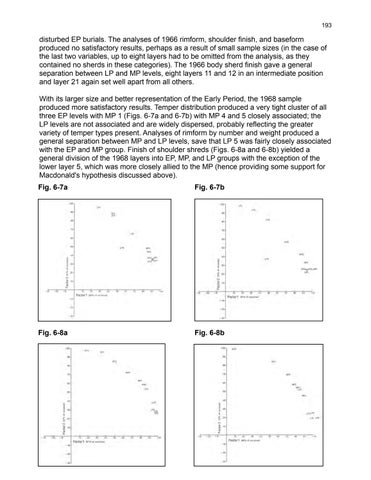193
disturbed EP burials. The analyses of 1966 rimform, shoulder finish, and baseform produced no satisfactory results, perhaps as a result of small sample sizes (in the case of the last two variables, up to eight layers had to be omitted from the analysis, as they contained no sherds in these categories). The 1966 body sherd finish gave a general separation between LP and MP levels, eight layers 11 and 12 in an intermediate position and layer 21 again set well apart from all others. With its larger size and better representation of the Early Period, the 1968 sample produced more satisfactory results. Temper distribution produced a very tight cluster of all three EP levels with MP 1 (Figs. 6-7a and 6-7b) with MP 4 and 5 closely associated; the LP levels are not associated and are widely dispersed, probably reflecting the greater variety of temper types present. Analyses of rimform by number and weight produced a general separation between MP and LP levels, save that LP 5 was fairly closely associated with the EP and MP group. Finish of shoulder shreds (Figs. 6-8a and 6-8b) yielded a general division of the 1968 layers into EP, MP, and LP groups with the exception of the lower layer 5, which was more closely allied to the MP (hence providing some support for Macdonald's hypothesis discussed above). Fig. 6-7a
Fig. 6-7b
Fig. 6-8a
Fig. 6-8b
